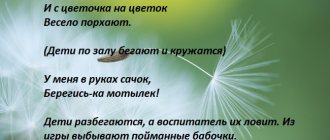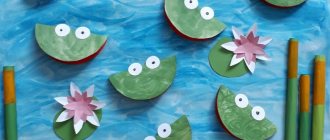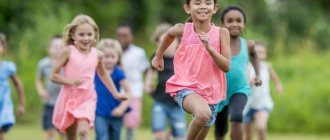Outdoor games in the preparatory group during a walk in kindergarten
A card index of outdoor games during a walk is presented for preschool children in the preparatory group of a kindergarten.
"White bears"
Goal: Develop speed, agility, endurance.
Progress of the game: On the edge of the area, which represents the sea, a small place is outlined - an ice floe. The driver standing on it is a “polar bear”. The remaining “cubs” will be randomly placed throughout the site.
“The Bear” growls: “I’m going out to fish!” - and runs to catch the “cubs”. Having caught one “bear cub”, he takes it to the ice floe, then catches another. After this, the two caught “bear cubs” join hands and begin to catch the rest of the players. At this time, the “bear” retreats to the ice floe. Having overtaken someone, two “bear cubs” join their free hands so that the caught one ends up between the hands, and shout: “Bear, help!” The “bear” runs up, greases the caught one and takes him to the ice floe. The next two caught also join hands and catch the rest of the “cubs”. The game continues until all the cubs are caught.
The last player caught wins and becomes the “polar bear”.
Rules: A caught “bear cub” cannot slip out from under the hands of the pair surrounding it until the “bear” insults it. When catching, it is forbidden to grab players by their clothes, and those running away are prohibited from running outside the boundaries of the area.
Outdoor game “At the bear in the forest.”
Goal: To develop children’s self-control, the ability to perform movements on a signal, and the skill of collective movement. Practice running in a certain direction, with dodging, develop speech,
Progress of the game: A line is drawn on one side of the site - this is the edge of the forest. Beyond the line, at a distance of 2-3 steps, a place for a bear is outlined. On the opposite side is the children's house. The teacher appoints the bear, the rest of the children - at home. The teacher says: “Go for a walk!” Children head to the edge of the forest, picking berries and mushrooms, imitating movements and saying in chorus: “I take berries and mushrooms from a bear in the forest. And the bear sits and growls at us.” The bear is sitting in its place at this time. When the players say “Roars!” the bear gets up, the children run home. The bear tries to catch them - to touch them. The bear takes the caught one to his place. After 2-3 caught, a new bear is selected.
L.I. Penzulaeva “Physical education in kindergarten” (preparatory group) 2015
Game "Be careful"
Goal: to teach children to quickly run after objects, listening to the command which object needs to be brought. Develop attention, dexterity, speed of movement.
Progress of the game: On one side of the court there are 5-6 players, on the opposite side (distance 8-10m) in front of each of them there are three objects (a cube, a rattle, a flag) to the signal “Run!” children rush towards objects. Approximately halfway along the path there is a signal indicating which of the three objects you need to take, for example a cube. Children take the named object and run with it to the starting line, the one who brought the object first wins, if the wrong object is taken, you need to go back and replace it.
Option 2
Tell the children right away which item to bring. Run to take the object and lift it up.
"Tag with a skipping rope"
Goal: to teach children to run in pairs or threes around the playground, holding on to a jump rope, trying to make fun of the children running around in all directions. Develop the ability to act coordinatedly in pairs, threes, coordination of movements, dexterity.
Progress of the game: Two children take an ordinary short jump rope by the ends, run around the playground, trying with their free hand to insult the rest of the children running away from them. The first one caught stands between the drivers, grabs the middle of the rope with one hand and joins in the catch. In order for the three drivers to be freed from their duties, each of them needs to catch one player.
Complication: include 2 pairs of traps in the game.
"Owl"
Goal: to teach children to act on a signal, run, scatteredly imitating birds, and maintain a motionless posture. Develop balance.
Progress of the game:
All the birds are playing, one child is an owl, which is located on the side of the playground. At the signal “day,” the birds fly away, flap their wings, and peck grains. At the signal “night” everyone stops and stands motionless. An owl flies out, looks out for those who move and takes them into the nest. in 15-20 seconds. The “day” signal is given again, the owl flies to the nest, and the children - birds fly around the playground.
"Changing Places"
Goal: to teach children to run from one side of the playground to the other in a line without bumping into each other. Develop the ability to form a line evenly, to act in concert, on a signal. Strengthen the side gallop, running with straight legs.
Progress of the game: Two teams of 8-10 people line up in lines facing each other on opposite sides of the site behind the city lines (distance 10-12m), and diverge to the width of outstretched arms. At a signal, they run towards each other, trying to get outside the opposite city as quickly as possible, then turn to face the center of the site and line up. The team that does it faster wins.
Option 2.
Cross at a side gallop, with straight legs.
"Giants and Dwarves"
Purpose: To train children to act on a signal.
Progress of the game : The driver (most often an adult) explains to the children that he can only pronounce the words “giants” and “gnomes”. When the word “giants” is said, everyone should rise on their toes and raise their hands. And when you hear the word “gnomes,” everyone should sit down lower. The one who makes a mistake is out of the game.
Of course, the driver wants to ensure that the players make mistakes. To do this, he first pronounces the words “giants!” loudly and in a bass voice, and the “gnomes” - in a quiet, squeaky whisper. And then, at some point, it’s the other way around. Or when saying “giants,” the driver squats, and when saying “gnomes,” he rises on his tiptoes.
The pace of the game is accelerating and all players are gradually dropping out. The last player who has never made a mistake becomes the driver.
Outdoor game “Migration of birds”
Goal: To practice climbing, developing agility and strength.
Progress of the game:
On one side of the hall there are children - birds. On the other side there are various aids - gymnastic benches, cubes, etc. - these are trees. At the signal “Birds fly away!” children, flapping their arms like wings, scatter throughout the hall. At the signal “Storm!” all the birds run to the trees and try to take some place as quickly as possible. When the teacher says “The storm has stopped!” Children descend from the heights and scatter around the hall again - “the birds continue their flight.”
Outdoor game "Mousetrap"
Goal: To develop in children the ability to perform movements according to a signal, according to a word, quickly forming a circle. Practice the game together.
Progress of the game: The players are divided into two unequal groups. The smaller one (about a third of the players) forms a circle - a mousetrap. The rest represent mice and are outside the circle.
Children depicting a mousetrap hold hands and begin to walk in a circle, left and right, saying:
“Oh, how tired the mice are, Their passion has gone away. They've all gnawed, they've all eaten, they're climbing everywhere - here's a scourge.
Beware, cheats, we will get to you. Let’s set up mousetraps and catch them all at once.”
At the end of the poem, the children stop and raise their clasped hands up. The mice run into the mousetrap and immediately run out the other side. At the teacher's signal:
"Pop!" - children standing in a circle lower their hands and squat - the mousetrap is slammed shut. Mice that did not have time to run out of the circle are read as caught. They also stand in a circle (and the size of the mousetrap increases). When most of the mice are caught, the children change roles and the game resumes.
L.I. Penzulaeva “Physical education in kindergarten” (preparatory group) 2015
Game "Tag - don't fall into the swamp"
Goal: to teach children to run without running beyond visual cues, with dodging. Develop dexterity, speed of movement, spatial orientation.
Progress of the game: On the site, sticks, cones, and pebbles indicate a place where you cannot run - a swamp (anthill, vegetable garden). Choose a trap. At a signal, he catches up with the children, trying to make them dirty.
Haunted by the trap, he leaves the game.
Option 2.
The trap stands in the center of a circle drawn on the ground or made of cord. Children run in and out of the circle, and Trap tries to make fun of the one who doesn’t have time to run out of the circle.
Outdoor game “Run quietly”
Goal: learn to move silently.
Progress of the game: Children are divided into groups of 4-5 people, divided into three groups and lined up. They choose a driver, he sits in the middle of the platform and closes his eyes. At the signal, one subgroup silently runs past the driver to the other end of the site. If the driver hears, he says “Stop!” and those running stop. Without opening his eyes, the driver says which group was running. If he correctly indicated the group, the children move aside. If you make a mistake, they return to their places. All groups run through this one by one. The group that ran quietly and that the driver could not detect wins.
L.I. Penzulaeva “Physical education in kindergarten” (preparatory group) 2015
"Burners"
Goal: to teach children to run in pairs at speed, to start running only after finishing the words. To develop speed of movement and dexterity in children.
Progress of the game: Children stand in a column in pairs. A line is drawn in front of the column at a distance of 2-3 steps. According to the counting, a Trap is selected. He stands on the line with his back to the other children. Everyone standing in pairs says:
“Burn, burn clearly so that it doesn’t go out. Look at the sky - the birds are flying, the bells are ringing. One, two, three - run!”
With the end of the words, the children standing in the last pair run along the column (one on the right, the other on the left, trying to grab hands. The trap tries to catch one of the pair and connect hands with him.
If the catcher managed to do this, he forms a new pair with the caught one and stands in front of the column, and the one left without a pair becomes a trap. If the Trap is not caught, he remains in the same role.
While pronouncing the words, the Trap does not look back; you can catch before the players hold hands.
Outdoor game "Sparrows and the cat"
Goal: to train children to act in accordance with the text of the poem, to run in a straight direction at the same time as a whole group, to use the entire area of the hall.
Progress of the game: “Cat” is located on one side of the hall (area), and children – “sparrows” - on the other. Children - “little sparrows” approach the “cat” together with the teacher, who says: Kitty, kitten, cat, Kitty - a little black tail, he is lying on a log, pretending to be asleep. To the words “As if he’s sleeping,” the “cat” exclaims: “Meow!” - and begins to catch the “sparrows” who are running away from him to their house (beyond the line).
L.I. Penzulaeva “Physical education in kindergarten” (preparatory group) 2015
"Hot potato"
This is an active entertainment that brings all the children together in the yard. It perfectly develops such skills as dexterity, reaction speed, teamwork, strategic thinking, spatial orientation, and the time spent playing an exciting game flies by. All you need is a ball and a group of friends.
Goal: Remain the only person standing in the circle, seating your opponents in the center.
Description and rules of the game: from 6 to 12 children can participate in the entertainment. Children stand in a circle and begin to randomly throw each other the ball, which in this game is the “hot potato”. Everyone must catch the projectile and, without holding it in their hands for more than one second, throw it further. Players can also hit the ball with their palms instead of catching them to make the rules more difficult.
The participant is temporarily eliminated from the game and sits in the center of the circle if he did not catch, hit or drop the ball. The same thing happens to those who hold it in their hands for more than one second and are “burnt” by the hot potato.
You can return to the circle by catching the toy from a sitting position (standing up in the “penalty zone” is prohibited). If one person managed to do this, all participants inside return to the circle. In this case, the player who threw the ball takes their place.
If the ball, when thrown, touches someone sitting in the center of the circle, then that player returns to the circle. At the same time, all participants who touched it with their hands in the center of the circle also resume the game.
The action continues until one child remains in the circle, who is considered the winner.
Become the most dexterous and skillful in the yard!
Outdoor game "Don't get caught"
Purpose: to train children in jumping on two legs while moving forward
How to play: The players sit around a cord placed in the shape of a circle. In the center there are two drivers. At the teacher’s signal, children jump on two legs in a circle and jump out as the traps approach. Anyone who has been stained receives a penalty point. After 40-50 seconds, the game stops, the losers are counted, and the game is repeated with new drivers.
L.I. Penzulaeva “Physical education in kindergarten” (preparatory group) 2015
"Change the subject"
Goal: to teach children to quickly run to the opposite side of the site, take an object and give it to their friend. develop the ability to act in a team, follow the rules, agility, and general endurance. Cultivate persistence in achieving positive results.
Progress of the game: On one side of the court, the players stand behind the line, forming 4-5 columns. On the opposite side of the site, opposite each column, circles with a diameter of 60-80 cm are outlined. Each first person in the column holds a bag of sand, a cube or another object in his hands. The same object is placed in the center of each circle. At the signal, players run to the mugs, put down an object and take another, then run back to their place and raise the brought object above their heads. The one who did it first is considered the winner. Those who come running pass the objects to those standing behind them, and they themselves run to the end of the column. When everyone has completed the task, the column with the most winnings is marked.
Complication: run after an object like a snake between the pins without dropping the pins.
Outdoor game "Bears and Bees"
Goal: practice running across the entire court, climbing the gym wall
How to play: The players are divided into two equal teams: one is bees, the other is bears.
On one side of the hall there is a beehive, and on the opposite side there is a meadow. To the side there is a den of bears. At a conditioned signal from the teacher, the bees fly out of the hive (they get off the heights of the gymnastic wall, gymnastic benches, etc.), buzz and fly to the meadow for honey. As soon as the bees fly away, the bears run out of the den, climb into the hive (climb onto elevated surfaces) and feast on honey. The teacher gives a signal:
“Bears!”, the bees fly to the hives, trying to sting (touch with their hands) the bears, they run away into the den. Stung bears miss one game. The game resumes, and after repetition, the children change roles.
Before the game, the teacher reminds the children that they need to get down from elevations, not jump, and climb onto the stairs no higher than the 4th or 5th rail.
L.I. Penzulaeva “Physical education in kindergarten” (preparatory group) 2015
Lesson outline: “Outdoor games for middle school age”
Shmaliy Vladislav RiSOT/b-19-1o
Target:
the use of outdoor games with elements of athletics for the comprehensive and harmonious development of children of secondary school age.
Tasks:
Educational - improving motor actions and physical qualities through outdoor games (speed, endurance, agility, coordination, strength), teaching low-start techniques.
Wellness – strengthening the morphofunctional systems of the body, the formation of the psychological properties of the body (logical thinking, imagination, memory, etc.) and positive emotions.
Educational – the formation of friendly and coordinated work, the formation of moral qualities: organization, independence, cultivating a sense of collectivism.
Method:
game, group.
Inventory
: large balls, gymnastic benches, whistle, relay baton, cubes.
| Lesson steps | Goals and objectives | Lesson content | Dosage |
| 1. Introductory part. | To interest students in the lesson, creating an emotional background. | Forming in one line, greeting, communicating the goals and objectives of the lesson. Turns in place. Repeat safety precautions. | 2 minutes |
| Prepare the body of those exercising for the upcoming load | Warm up in motion. Walking with a task. · on socks; · on the heels; · from heel to heel. Running on a mission. · on socks; · zigzag; · with acceleration; · in the opposite direction. Exercise to restore breathing. General development exercises (GDE): · I.P. o.s. hand jerks 1-2 right hand (forward, backward); 3-4 left hand. · I.P. o.s. 1-2 tilts to the right; 3-4 tilts to the left. · I.P. feet wider than shoulders 1-2 turns to the right; 3-4 turns to the left. · I.P. o.s. 1-2 swing of the right leg to the left hand; 3-4 swing of the left leg to the right hand. · I.P. legs wider than shoulders 1-2-3 tilts towards the left leg, in the middle, towards the right leg. 4 I.P. · I.P. o.s. 1 arms up, legs apart in a jump; 2 I.P. | 2 minutes. 2 minutes. 1 min. 5 minutes. | |
| 2. Main part. (25 minutes) | 25 minutes | ||
| 1. Low start technique training (presentation) | 7 minutes | ||
| Improving agility, coordination, speed. | "Silver Belt" Relay Race. The kids' task is to run to the wall from a low start, touch it with their hand, run back, and pass the baton to the next one. The team that runs to the finish line faster wins. | 2 minutes | |
| Improving reaction speed, endurance, accuracy. | “Pass the ball to the next one.” A gymnastic bench is placed in front of each team at a distance of 10 meters. The player with the ball in his hands must run around the bench, make a circle, sit on it facing the team and throw the ball to the next player. The team that gets to the bench the fastest wins. | 3 minutes | |
| Improving agility, coordination, speed. | “Who is faster?” Two cubes lie 10-15 meters from the teams; each participant must in his own way (in single file, on one leg, backwards) reach the hat and bring it to the team. The team that finishes faster wins. | 3 minutes | |
| Improving agility, coordination, speed, ingenuity. | “Snipers” The players are divided into two teams (by counting or by agreement). Each team selects a “sniper”, the rest become ordinary players. Everything is placed like this:
| 8 minutes | |
| Improving agility, coordination, speed. | “Gather the harvest” (from a low start) All children are divided into 2 teams and line up in 2 columns. Opposite the teams, at a distance of 10-15 meters, there are hoops containing vegetables and fruits. Near each team there is a basket where they need to collect the “harvest”. On command, the first participants run into the hoop, take an object, run around the hoop and return back. As soon as the previous player puts an item in the basket and touches the shoulder of the next player, that player runs to the hoop, etc., the team that “harvests the harvest” the fastest wins. | 2 minutes | |
| 3. Final part. | Restore the body after physical activity. | 1. Relaxation. 2. Construction. Summing up the lessons. 3. Homework. | 3 minutes |




